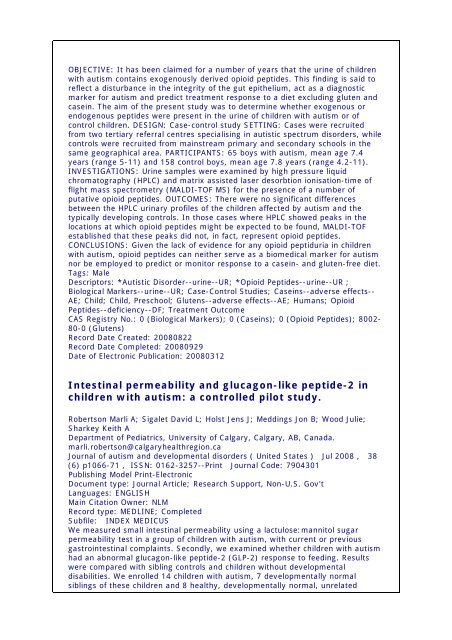Change Of Diet For children With Autism Suffering - Nutrition and ...
Change Of Diet For children With Autism Suffering - Nutrition and ...
Change Of Diet For children With Autism Suffering - Nutrition and ...
Create successful ePaper yourself
Turn your PDF publications into a flip-book with our unique Google optimized e-Paper software.
OBJECTIVE: It has been claimed for a number of years that the urine of <strong>children</strong><br />
with autism contains exogenously derived opioid peptides. This finding is said to<br />
reflect a disturbance in the integrity of the gut epithelium, act as a diagnostic<br />
marker for autism <strong>and</strong> predict treatment response to a diet excluding gluten <strong>and</strong><br />
casein. The aim of the present study was to determine whether exogenous or<br />
endogenous peptides were present in the urine of <strong>children</strong> with autism or of<br />
control <strong>children</strong>. DESIGN: Case-control study SETTING: Cases were recruited<br />
from two tertiary referral centres specialising in autistic spectrum disorders, while<br />
controls were recruited from mainstream primary <strong>and</strong> secondary schools in the<br />
same geographical area. PARTICIPANTS: 65 boys with autism, mean age 7.4<br />
years (range 5-11) <strong>and</strong> 158 control boys, mean age 7.8 years (range 4.2-11).<br />
INVESTIGATIONS: Urine samples were examined by high pressure liquid<br />
chromatography (HPLC) <strong>and</strong> matrix assisted laser desorbtion ionisation-time of<br />
flight mass spectrometry (MALDI-TOF MS) for the presence of a number of<br />
putative opioid peptides. OUTCOMES: There were no significant differences<br />
between the HPLC urinary profiles of the <strong>children</strong> affected by autism <strong>and</strong> the<br />
typically developing controls. In those cases where HPLC showed peaks in the<br />
locations at which opioid peptides might be expected to be found, MALDI-TOF<br />
established that these peaks did not, in fact, represent opioid peptides.<br />
CONCLUSIONS: Given the lack of evidence for any opioid peptiduria in <strong>children</strong><br />
with autism, opioid peptides can neither serve as a biomedical marker for autism<br />
nor be employed to predict or monitor response to a casein- <strong>and</strong> gluten-free diet.<br />
Tags: Male<br />
Descriptors: *Autistic Disorder--urine--UR; *Opioid Peptides--urine--UR ;<br />
Biological Markers--urine--UR; Case-Control Studies; Caseins--adverse effects--<br />
AE; Child; Child, Preschool; Glutens--adverse effects--AE; Humans; Opioid<br />
Peptides--deficiency--DF; Treatment Outcome<br />
CAS Registry No.: 0 (Biological Markers); 0 (Caseins); 0 (Opioid Peptides); 8002-<br />
80-0 (Glutens)<br />
Record Date Created: 20080822<br />
Record Date Completed: 20080929<br />
Date of Electronic Publication: 20080312<br />
Intestinal permeability <strong>and</strong> glucagon-like peptide-2 in<br />
<strong>children</strong> with autism: a controlled pilot study.<br />
Robertson Marli A; Sigalet David L; Holst Jens J; Meddings Jon B; Wood Julie;<br />
Sharkey Keith A<br />
Department of Pediatrics, University of Calgary, Calgary, AB, Canada.<br />
marli.robertson@calgaryhealthregion.ca<br />
Journal of autism <strong>and</strong> developmental disorders ( United States ) Jul 2008 , 38<br />
(6) p1066-71 , ISSN: 0162-3257--Print Journal Code: 7904301<br />
Publishing Model Print-Electronic<br />
Document type: Journal Article; Research Support, Non-U.S. Gov't<br />
Languages: ENGLISH<br />
Main Citation Owner: NLM<br />
Record type: MEDLINE; Completed<br />
Subfile: INDEX MEDICUS<br />
We measured small intestinal permeability using a lactulose:mannitol sugar<br />
permeability test in a group of <strong>children</strong> with autism, with current or previous<br />
gastrointestinal complaints. Secondly, we examined whether <strong>children</strong> with autism<br />
had an abnormal glucagon-like peptide-2 (GLP-2) response to feeding. Results<br />
were compared with sibling controls <strong>and</strong> <strong>children</strong> without developmental<br />
disabilities. We enrolled 14 <strong>children</strong> with autism, 7 developmentally normal<br />
siblings of these <strong>children</strong> <strong>and</strong> 8 healthy, developmentally normal, unrelated


